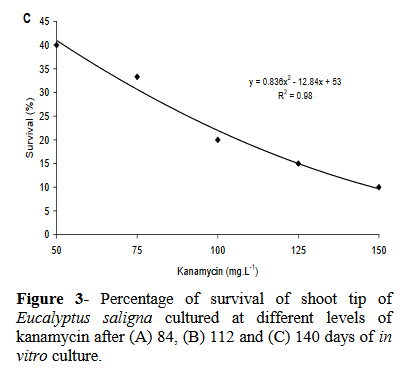Shoot tip and cotyledon explants of Eucalyptus saligna Sm. cultivated on different kanamycin levels
DOI:
https://doi.org/10.20873/jbb.uft.cemaf.v1n1.silvaKeywords:
Eucalypt, woody plant, genetic transformationAbstract
An efficient selec tive agent helps to obtain transgenic plant s; the most used selective agent for genetic transformation of Eucalypt is kanamycin. The aim of this research was to determine ideal dose of kanamycin in shoot tip and cotyledon explants of E. saligna for use as selective agent in genetic transformation. Two experiments were carried out, first in order to test effects of the kanamycin in cotyledons and second, in order to test effects of the kanamycin in shoot tip. In the cotyledons experiment were tested 0, 12.5, 25, 37.5 and 50 mg.L-1 kanamycin on a callus formation medium and for shoot tip were tested 50, 75, 100, 125 and 150 mg.L-1 kanamycin on a multiplication medium. Cotyledons can be selected more quickly than shoot tip, moreover needs lower kanamycin levels than shoot tip, what results more speed and economy during genetic transformation process. It is probable that levels lower than 12.5 mg.L-1 kanamycin must be ideal for the cotyledons selection and 50 mg.L-1kanamycin for shoot tip.

Published
How to Cite
Issue
Section
License
Copyright (c) 2024 - Journal of Biotechnology and Biodiversity

This work is licensed under a Creative Commons Attribution 4.0 International License.
Authors who publish with this journal agree to the following terms:
Authors retain copyright and grant the journal right of first publication with the work simultaneously licensed under a Creative Commons Attribution License (CC BY 4.0 at http://creativecommons.org/licenses/by/4.0/) that allows others to share the work with an acknowledgement of the work's authorship and initial publication in this journal.
Authors are able to enter into separate, additional contractual arrangements for the non-exclusive distribution of the journal's published version of the work (e.g., post it to an institutional repository or publish it in a book), with an acknowledgement of its initial publication in this journal.
Authors are permitted and encouraged to post their work online (e.g. in institutional repositories or on their website) prior to and during the submission process, as it can lead to productive exchanges, as well as earlier and greater citation of published work (Available at The Effect of Open Access, at http://opcit.eprints.org/oacitation-biblio.html).


